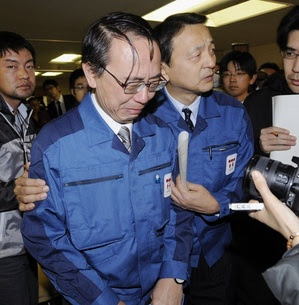
As we all know, a large earthquake and tsunami that has swept through the coast of Japan on March 11th of this year has caused a extreme meltdown at a nuclear plant in Fukushima, Japan.
2 months after the disaster, the meltdown is still an ongoing stage.
Chernobyl 1986
On 26 April 1986, in Chernobyl, reactor four suffered a catastrophic power increase, leading to explosions in its core. This dispersed large quantities of radioactive fuel and core materials into the atmosphere and ignited the combustible graphite moderator. The burning graphite moderator increased the emission of radioactive particles, carried by the smoke, as the reactor had not been encased by any kind of hard containment vessel.

An explosion and fire released large quantities of radioactive contamination into the atmosphere, which spread over much of Western USSR and Europe. It is considered the worst nuclear power plant accident in history, and is one of only two classified as a level 7 event on the International Nuclear Event Scale (the other being the Fukushima I nuclear accidents).

An estimated 15,000 to 30,000 people have died in the aftermath. More than 2.5 million Ukranians suffer from health problems related to the Chernobyl blast, with 80,000 of them receiving a pension.

The town of Pripyat became abandoned after the explosion in Chernobyl.

2 months after the Fukushima nuclear accident, experts are now saying that Fukushima could leave a worse scar than the Chernobyl accident.

Fukushima, March 11, 2011
Following the 9.0 earthquake and the tsunami in the Sendai region of Japan, Japan initially announced that the nuclear plant has shut down and the core temperature has been rising due to the disabled generators.

At 7:03 pm, on the day of the disaster, Japanese Prime Minister Naoto Kan declares a nuclear emergency status. Japan comforted the people by telling them that the warnings are just "safety precautions" and everything was "under control" and that the damages were "minimal". They also announced that the nuclear plant had no radioactive leaks.

On the following day, media sources reported that Japan was pouring seawater into the plant. No one questioned or answered why they were putting seawater into the plant. Were they out of water? Now we know that they were mixing small amount of Boron to slowdown the rising temperatures. Now we also know that the 1st reactor was already leaking the day after the disaster.

Japan was hiding the fast meltdown process and on March 12th, due to hydrogen explosions they release steam that contains radioactive materials. Soon they announce that the steam only had "some" radioactive materials and it's acceptable level of radiation.

Soon the whole world was worreid that the blowing wind would carry the radiation and spread to other regions. America, France, Germany, Canada all reported that it was an acceptable level of radioactivity. OH BULL! Researchers in the United States have performed thousands of radiation experiments in humans to determine the effects of ionizing radiation and radioactive contamination on the human body. US Government experiments with radiation.
Managing Director, Akio Komori of the Tokyo Electric Power Company (TEPCO), the company that manages the Fukushima nuclear plant, cried after a press conference. He admitted that the ongoing radiation leaks were serious enough to cause injury or death in the highest area of danger, closest to the damaged plant.

2 months after the disaster, Fukushima nuclear plants are still out of control and the work is still being done to lower the core temperature. Although the world knows more now about the plants than we did before, we are still ignorant of things that the Japanese Government is hiding from the rest of the world. Releasing steams and releasing nuclear radiation into the ocean.... Now what's next?
No wonder Germany and other countries are considering not using nuclear power plants.
ReplyDeleteAwesome article!
ReplyDeleteMad shoppers check this site out